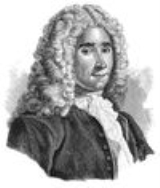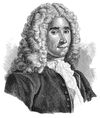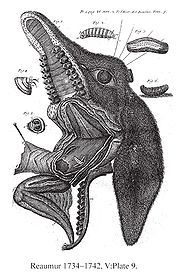
René Antoine Ferchault de Réaumur
Encyclopedia

La Rochelle
La Rochelle is a city in western France and a seaport on the Bay of Biscay, a part of the Atlantic Ocean. It is the capital of the Charente-Maritime department.The city is connected to the Île de Ré by a bridge completed on 19 May 1988...
- 17 October 1757 Saint-Julien-du-Terroux
Saint-Julien-du-Terroux
Saint-Julien-du-Terroux is a commune in the Mayenne department in north-western France.-References:*...
) was a French
French people
The French are a nation that share a common French culture and speak the French language as a mother tongue. Historically, the French population are descended from peoples of Celtic, Latin and Germanic origin, and are today a mixture of several ethnic groups...
scientist who contributed to many different fields, especially the study of insects
Entomology
Entomology is the scientific study of insects, a branch of arthropodology...
.
Life
Réaumur was born in a prominent La Rochelle family and educated in Paris. He learned philosophyPhilosophy
Philosophy is the study of general and fundamental problems, such as those connected with existence, knowledge, values, reason, mind, and language. Philosophy is distinguished from other ways of addressing such problems by its critical, generally systematic approach and its reliance on rational...
in the Jesuits'
Society of Jesus
The Society of Jesus is a Catholic male religious order that follows the teachings of the Catholic Church. The members are called Jesuits, and are also known colloquially as "God's Army" and as "The Company," these being references to founder Ignatius of Loyola's military background and a...
college at Poitiers
Poitiers
Poitiers is a city on the Clain river in west central France. It is a commune and the capital of the Vienne department and of the Poitou-Charentes region. The centre is picturesque and its streets are interesting for predominant remains of historical architecture, especially from the Romanesque...
, and in 1699 went to Bourges
Bourges
Bourges is a city in central France on the Yèvre river. It is the capital of the department of Cher and also was the capital of the former province of Berry.-History:...
to study civil law
Civil law (legal system)
Civil law is a legal system inspired by Roman law and whose primary feature is that laws are codified into collections, as compared to common law systems that gives great precedential weight to common law on the principle that it is unfair to treat similar facts differently on different...
and mathematics
Mathematics
Mathematics is the study of quantity, space, structure, and change. Mathematicians seek out patterns and formulate new conjectures. Mathematicians resolve the truth or falsity of conjectures by mathematical proofs, which are arguments sufficient to convince other mathematicians of their validity...
under the charge of an uncle, canon of La Sainte-Chapelle. In 1703 he came to Paris, where he continued the study of mathematics
Mathematics
Mathematics is the study of quantity, space, structure, and change. Mathematicians seek out patterns and formulate new conjectures. Mathematicians resolve the truth or falsity of conjectures by mathematical proofs, which are arguments sufficient to convince other mathematicians of their validity...
and physics
Physics
Physics is a natural science that involves the study of matter and its motion through spacetime, along with related concepts such as energy and force. More broadly, it is the general analysis of nature, conducted in order to understand how the universe behaves.Physics is one of the oldest academic...
, and in 1708, aged only twenty-four, was nominated by Pierre Varignon
Pierre Varignon
Pierre Varignon was a French mathematician. He was educated at the Jesuit College and the University in Caen, where he received his M.A. in 1682. He took Holy Orders the following year....
(who taught him mathematics) and elected a member of the Académie des Sciences
French Academy of Sciences
The French Academy of Sciences is a learned society, founded in 1666 by Louis XIV at the suggestion of Jean-Baptiste Colbert, to encourage and protect the spirit of French scientific research...
. From this time onwards for nearly half a century hardly a year passed in which the Mémoires de l'Académie did not contain at least one paper by Réaumur.
At first his attention was occupied by mathematical studies, especially in geometry
Geometry
Geometry arose as the field of knowledge dealing with spatial relationships. Geometry was one of the two fields of pre-modern mathematics, the other being the study of numbers ....
. In 1710 he was placed in charge of a major government project–the official description of the useful arts and manufactures–which resulted in the establishment of manufactures new to France and the revival of neglected industries. For discoveries regarding iron and steel he was awarded a pension of 12,000 livre
Livré
Livré-la-Touche is a commune in the Mayenne department in north-western France. Prior to October 6, 2008, it was known as Livré....
s; but, content with his ample private income, he requested that the money should go to the Académie des Sciences for the furtherance of experiments on improved industrial processes. In 1731 he became interested in meteorology
Meteorology
Meteorology is the interdisciplinary scientific study of the atmosphere. Studies in the field stretch back millennia, though significant progress in meteorology did not occur until the 18th century. The 19th century saw breakthroughs occur after observing networks developed across several countries...
, and invented the thermometer
Thermometer
Developed during the 16th and 17th centuries, a thermometer is a device that measures temperature or temperature gradient using a variety of different principles. A thermometer has two important elements: the temperature sensor Developed during the 16th and 17th centuries, a thermometer (from the...
scale which bears his name: the Réaumur. In 1735, for family reasons, he accepted the post of commander and intendant of the royal and military order of Saint-Louis; he discharged his duties with scrupulous attention, but refused the pay. He took great delight in the systematic study of natural history. His friends often called him "the Pliny
Pliny the Elder
Gaius Plinius Secundus , better known as Pliny the Elder, was a Roman author, naturalist, and natural philosopher, as well as naval and army commander of the early Roman Empire, and personal friend of the emperor Vespasian...
of the 18th century".
He loved retirement and lived at his country residences, including La Bermondière (Maine
Maine (province)
Le Maine is one of the traditional provinces of France . It corresponds to the old county of Maine, with its center, the city of Le Mans.-Location:...
), where he had a serious fall from a horse, which led to his death. He bequeathed his manuscripts, which filled 138 portfolios, and his natural history collections to the Académie des Sciences.
Réaumur’s scientific papers deal with many branches of science; his first, in 1708, was on a general problem in geometry; his last, in 1756, on the forms of birds' nests. He proved experimentally the fact that the strength of a rope
Rope
A rope is a length of fibres, twisted or braided together to improve strength for pulling and connecting. It has tensile strength but is too flexible to provide compressive strength...
is more than the sum of the strengths of its separate strands. He examined and reported on the auriferous (gold-bearing) rivers, the turquoise
Turquoise
Turquoise is an opaque, blue-to-green mineral that is a hydrous phosphate of copper and aluminium, with the chemical formula CuAl648·4. It is rare and valuable in finer grades and has been prized as a gem and ornamental stone for thousands of years owing to its unique hue...
mines, the forests and the fossil
Fossil
Fossils are the preserved remains or traces of animals , plants, and other organisms from the remote past...
beds of France. He devised the method of tinning
Tinning
Tinning is the process of thinly coating sheets of wrought iron or steel with tin, and the resulting product is known as tinplate. It is most often used to prevent rust....
iron that is still employed, and investigated the differences between iron and steel, correctly showing that the amount of carbon
Carbon
Carbon is the chemical element with symbol C and atomic number 6. As a member of group 14 on the periodic table, it is nonmetallic and tetravalent—making four electrons available to form covalent chemical bonds...
(sulphur in the language of the old chemistry) is greatest in cast iron
Cast iron
Cast iron is derived from pig iron, and while it usually refers to gray iron, it also identifies a large group of ferrous alloys which solidify with a eutectic. The color of a fractured surface can be used to identify an alloy. White cast iron is named after its white surface when fractured, due...
, less in steel
Steel
Steel is an alloy that consists mostly of iron and has a carbon content between 0.2% and 2.1% by weight, depending on the grade. Carbon is the most common alloying material for iron, but various other alloying elements are used, such as manganese, chromium, vanadium, and tungsten...
, and least in wrought iron
Wrought iron
thumb|The [[Eiffel tower]] is constructed from [[puddle iron]], a form of wrought ironWrought iron is an iron alloy with a very low carbon...
. His book on this subject (1722) was translated into English and German.
He was noted for a thermometer
Thermometer
Developed during the 16th and 17th centuries, a thermometer is a device that measures temperature or temperature gradient using a variety of different principles. A thermometer has two important elements: the temperature sensor Developed during the 16th and 17th centuries, a thermometer (from the...
he constructed on the principle of taking the freezing point
Freezing Point
Freezing Point is a news journal in the People's Republic of China which has been the subject of controversy over its criticism of Communist Party officials and the sympathetic ear it lent to a Chinese historian who had criticized official history textbooks...
of water
Water
Water is a chemical substance with the chemical formula H2O. A water molecule contains one oxygen and two hydrogen atoms connected by covalent bonds. Water is a liquid at ambient conditions, but it often co-exists on Earth with its solid state, ice, and gaseous state . Water also exists in a...
as 0°, and graduating the tube into degrees each of which was one-thousandth of the volume contained by the bulb and tube up to the zero mark. It was an accident dependent on the dilatability of the particular quality of alcohol
Alcohol
In chemistry, an alcohol is an organic compound in which the hydroxy functional group is bound to a carbon atom. In particular, this carbon center should be saturated, having single bonds to three other atoms....
employed which made the boiling-point of water 80°; and mercurial thermometers the stems of which are graduated into eighty equal parts between the freezing- and boiling-points of water are not Réaumur thermometers in anything but name.
Réaumur wrote much on natural history. Early in life he described the locomotor system of the Echinodermata, and showed that the supposed vulgar error of crustacean
Crustacean
Crustaceans form a very large group of arthropods, usually treated as a subphylum, which includes such familiar animals as crabs, lobsters, crayfish, shrimp, krill and barnacles. The 50,000 described species range in size from Stygotantulus stocki at , to the Japanese spider crab with a leg span...
s replacing their lost limbs was actually true. He has been considered as a founder of ethology
Ethology
Ethology is the scientific study of animal behavior, and a sub-topic of zoology....
. In 1710 he wrote a paper on the possibility of spiders being used to produce silk
Silk
Silk is a natural protein fiber, some forms of which can be woven into textiles. The best-known type of silk is obtained from the cocoons of the larvae of the mulberry silkworm Bombyx mori reared in captivity...
, which was so celebrated at the time that the Chinese emperor Kang-he had it translated into Chinese.
He studied the relationship between the growth of insects and temperature. He also computed the rate of growth of insect populations and noted that there must be natural checks since the theoretical population numbers achieveable by geometric progression
Geometric progression
In mathematics, a geometric progression, also known as a geometric sequence, is a sequence of numbers where each term after the first is found by multiplying the previous one by a fixed non-zero number called the common ratio. For example, the sequence 2, 6, 18, 54, ... is a geometric progression...
were not matched by observations of actual populations.
He also studied botanical and agricultural matters, and devised processes for preserving birds and eggs. He elaborated a system of artificial incubation
Avian incubation
Incubation refers to the process by which certain oviparous animals hatch their eggs, and to the development of the embryo within the egg. The most vital factor of incubation is the constant temperature required for its development over a specific period. Especially in domestic fowl, the act of...
, and made important observations on the digestion of carnivorous and graminivorous (grass-eating) birds. One of his greatest work is the Mémoires pour servir à l'histoire des insectes, 6 vols., with 267 plates (Amsterdam, 1734–42). It describes the appearance, habits and locality of all the known insects except the beetles, and is a marvel of patient and accurate observation. Among other important facts stated in this work are the experiments which enabled Réaumur to prove the correctness of Peyssonel's hypothesis, that coral
Coral
Corals are marine animals in class Anthozoa of phylum Cnidaria typically living in compact colonies of many identical individual "polyps". The group includes the important reef builders that inhabit tropical oceans and secrete calcium carbonate to form a hard skeleton.A coral "head" is a colony of...
s are animals and not plants.
He was elected a Fellow of the Royal Society in November 1738 by virtue of the fact that "His Name hath been known for many years among the Learned by Several Curious disertations published in the Memoirs of the Royal Academy of Sciences at Paris & in particular by a very Learned and usefull book wrote in French entitled 'The Art of Converting Forged Iron into Steel' and 'the Art of Soft'ning Cast Iron' printed at Paris 1722 4to and lately by his 'Curious Memoires relating to the History of Insects' at paris in 4to three Volumes of which work have been Laid before the Royal Society". He was elected a foreign member of the Royal Swedish Academy of Sciences
Royal Swedish Academy of Sciences
The Royal Swedish Academy of Sciences or Kungliga Vetenskapsakademien is one of the Royal Academies of Sweden. The Academy is an independent, non-governmental scientific organization which acts to promote the sciences, primarily the natural sciences and mathematics.The Academy was founded on 2...
in 1748.
Selected works

- Réaumur, R.-A. F. de. 1734–1742. Mémoires pour servir à l’histoire des insectes. Six volumes. Académie Royale des Sciences, Paris, France.
- Réaumur, R.-A. F. de. 1749. Art de faire éclorre et d’élever en tout saison des oiseaux Domestiques de toutes espèces. Two volumes. Imprimerie royale, Paris, France.
- Réaumur, R.-A. F. de. 1750. The art of hatching and bringing up domestic fowls. London, UK.
- Réaumur, R.-A. F. de. 1800. Short history of bees I. The natural history of bees . . . Printed for Vernor and Hood in the Poultry, by J. Cundee, London, UK.
- Réaumur, R.-A. F. de. 1926. The natural history of ants, from an unpublished manuscript. W. M. Wheeler, editor and translator. [Includes French text.] Knopf, New York, New York, USA. Reprinted 1977. Arno Press, New York, New York, USA.
- Réaumur, R.-A. F. de. 1939. Morceaux choisis. Jean Torlais, editor. Gallimard, Paris, France.
- Réaumur, R.-A. F. de. 1955. Histoire des scarabées. M. Caullery, introduction. Volume 11 of Encyclopédie Entomologique. Paul Lechevalier, Paris, France.
- Réaumur, R.-A. F. de. 1956. Memoirs on steel and iron. A. G. Sisco, translator. C. S. Smith, introduction and notes. University of Chicago Press, Chicago, Illinois, USA.

